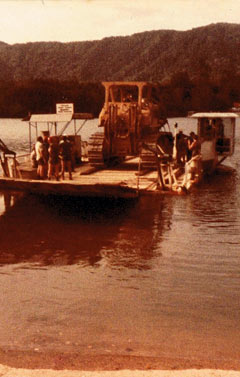1984 Blockade
In August 1984, hostilities resumed. Conservationists had spent the first half of the year lobbying the federal government to intervene, without success. The state government dug in behind Douglas Shire Council's plans to build the road.
When the workers arrived to finish the job, the protests were ready. Their numbers were greater and the arrival of more NAGs from down south added more colour to the campaign ñ they arrived in a rainbow painted bus. The protesters set up a radio network to connect Cape Tribulation with Bloomfield, Port Douglas and other places in-between.
But the council and police were also better organised, and had a new-found resolve to finish the job. On the 8 August work began. The police presence was strong and the media were there en masse. A group of hole-sitters were removed with help from the council backhoe (the previous year they'd used an empty pineapple tin). Further attempts to slow proceedings ñ a protester chained to the backhoe, others buried under a pile of logs were quickly dismantled. The protesters again took to the trees.
The tree campaign proved to be the most effective of the 1984 protest. Among the tree-sitters was Gummy, defender of the forests, who held out the longest, precariously perched in a very strategic tree. He was also equipped with a two-way radio and was patched into the network to get news of Council's progress out to the rest of the campaign. As the police enforced a media ban of the work site, and other protesters struggled to get close to the action, Gummy's radio reports became a vital source of information.
Other attempts to frustrate the council workers and police were met with a fast response. Two protesters dressed up like officials were quickly rounded up after bringing a bulldozer to a standstill; a boat that formed part of the radio network was raided; and attempts to resupply the tree-sitters with food and water were met with the Police Dog Squad. The remaining tree-sitters were coaxed out of the trees with the threat of more damage to the forests if the dozers were forced to go around them. With a lack of resources and people on the ground, the blockade collapsed.

